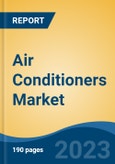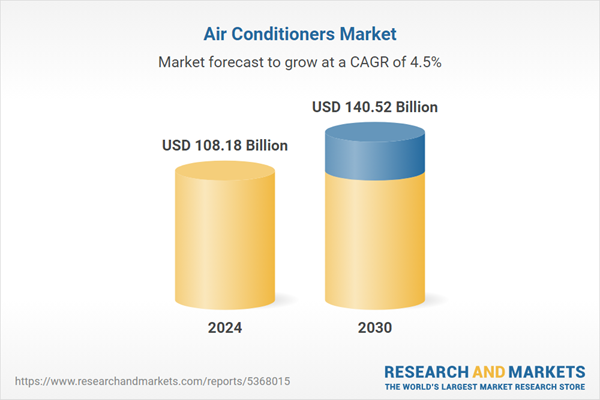Speak directly to the analyst to clarify any post sales queries you may have.
10% Free customizationThis report comes with 10% free customization, enabling you to add data that meets your specific business needs.
Key Market Drivers
Rising Urbanization and Increasing Disposable Income
One of the most significant drivers of the global air conditioners market is the rapid urbanization occurring across developing and developed regions. In 2024, India's urban population stands at 461 million, growing at 2.3% annually, with cities expected to contribute 75% of the nation's income by 2031. As more people migrate to cities for better employment and lifestyle opportunities, the demand for modern residential and commercial infrastructure grows.Urban households increasingly prefer comfortable living environments, which include air conditioning as a standard amenity. Alongside urbanization, rising disposable incomes are enabling consumers to afford advanced cooling solutions. Middle-class households in countries such as China, India, Brazil, and Southeast Asian nations are expanding rapidly, fueling the demand for energy-efficient and technologically advanced air conditioners. The growing willingness to invest in comfort and convenience directly boosts market adoption, particularly for residential ACs, window units, and split systems.
Key Market Challenges
High Energy Consumption and Operational Costs
One of the primary challenges restraining the growth of the global air conditioners market is the high energy consumption associated with conventional AC systems. Air conditioners, particularly older models and non-inverter units, consume significant amounts of electricity, leading to increased operational costs for consumers and businesses. In regions with high electricity tariffs, this can make air conditioning less affordable, especially for middle- and lower-income households. Additionally, rising energy consumption contributes to environmental concerns such as greenhouse gas emissions and climate change, prompting governments to impose stricter energy efficiency regulations. These factors collectively discourage widespread adoption of air conditioning in price-sensitive markets and create a demand for more energy-efficient solutions, which often come at a higher upfront cost.Key Market Trends
Growing Adoption of Smart and IoT-Enabled Air Conditioners
One of the most prominent trends in the air conditioners market is the increasing adoption of smart and IoT-enabled systems. In 2024, the U.S. Department of Energy's Appliance and Equipment Standards Program implemented efficiency standards for over 70 products, including smart home appliances, resulting in a USD 105 billion reduction in utility bills for American households and businesses. Modern consumers are seeking devices that offer convenience, remote control, and energy efficiency, driving manufacturers to integrate connectivity features into their products.Smart ACs can be controlled via mobile apps, voice assistants, or home automation systems, allowing users to schedule operations, adjust temperature settings remotely, and monitor energy consumption in real-time. Additionally, these systems often incorporate AI-based learning algorithms that optimize cooling patterns based on user behavior and environmental conditions, further enhancing efficiency and comfort. The integration of IoT technology not only attracts tech-savvy consumers but also aligns with the broader smart home trend, making smart air conditioners a key growth segment globally.
Key Market Players
- Daikin Industries, Ltd.
- Gree Electric Appliances Inc.
- Midea Group Co., Ltd.
- Carrier Global Corporation
- Samsung Electronics Co., Ltd.
- Panasonic Corporation
- Mitsubishi Electric Corporation
- Johnson Controls-Hitachi Air Conditioning Limited
- Toshiba Corporation
- Trane Technologies plc
Report Scope:
In this report, the Global Air Conditioners Market has been segmented into the following categories, in addition to the industry trends which have also been detailed below:Air Conditioners Market, By Type:
- Splits
- VRF
- Windows
- HVAC Chillers
- Others
Air Conditioners Market, By End Use:
- Residential
- Commercial
Air Conditioners Market, By Distribution Channel:
- Supermarkets/Hypermarkets
- Multi-Branded Stores
- Online
- Others
Air Conditioners Market, By Region:
- North America
- United States
- Canada
- Mexico
- Europe
- France
- United Kingdom
- Italy
- Germany
- Spain
- Asia-Pacific
- China
- Japan
- India
- South Korea
- Vietnam
- South America
- Argentina
- Colombia
- Brazil
- Middle East & Africa
- South Africa
- Saudi Arabia
- UAE
- Turkey
Competitive Landscape
Company Profiles: Detailed analysis of the major companies present in the Global Air Conditioners Market.Available Customizations:
With the given market data, the publisher offers customizations according to a company's specific needs. The following customization options are available for the report.Company Information
- Detailed analysis and profiling of additional market players (up to five).
This product will be delivered within 1-3 business days.
Table of Contents
Companies Mentioned
- Daikin Industries, Ltd.
- Gree Electric Appliances Inc.
- Midea Group Co., Ltd.
- Carrier Global Corporation
- Samsung Electronics Co., Ltd.
- Panasonic Corporation
- Mitsubishi Electric Corporation
- Johnson Controls-Hitachi Air Conditioning Limited
- Toshiba Corporation
- Trane Technologies plc
Table Information
| Report Attribute | Details |
|---|---|
| No. of Pages | 189 |
| Published | September 2025 |
| Forecast Period | 2024 - 2030 |
| Estimated Market Value ( USD | $ 108.18 Billion |
| Forecasted Market Value ( USD | $ 140.52 Billion |
| Compound Annual Growth Rate | 4.4% |
| Regions Covered | Global |
| No. of Companies Mentioned | 10 |









